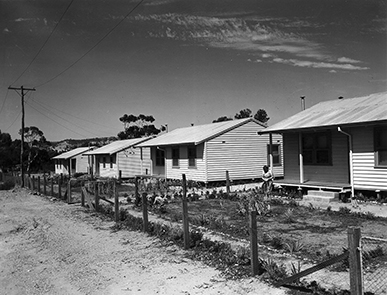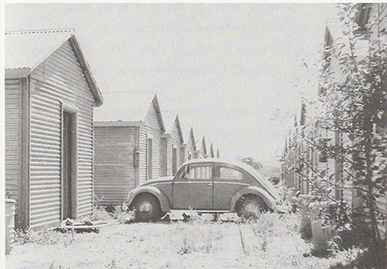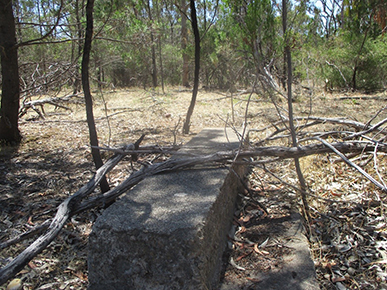Building a community, creating history
Life at South Para: The twenty house site
Constructing a dam on the South Para River was first proposed in a report to Parliament in 1878. But it wasn’t until September 1948—following years of drought and growing demand for water in Adelaide’s suburbs and industries—that the project was finally approved.
The twenty house site
Construction of the South Para Reservoir began in late 1948. Access roads were built, followed by the development of a small residential settlement, twenty timber-framed transportable homes built on a ridge above Victoria Creek. These houses were provided for young married workers and their families, creating a community that became fondly known as the Twenty House Site.

The employee housing at South Para known as the Twenty House Site
Among the residents were local workers, immigrants seeking a new life after World War II, and labourers from Yatala Labour Prison. Nearby, barrack-style huts were built for up to 200 single men, while seven additional houses were set aside for senior staff.

Huts where the workmen slept
Life at the camp was shaped by hard work, resilience, and strong social bonds. Families worked together, made their own entertainment, and created lasting memories during the decade-long construction of the dam.
Some more reflections from those that grew up at the reservoir:
Gloria Berryman
“I was born in Gawler in September 1955, but much of my earliest years were spent at the Twenty House Site. We lived in one of those buildings, it was a small house but full of life. My father was a boilermaker welder on the dam, my mother cared for us - it was hard work, but there was laughter too. I remember the sound of trucks rumbling by, and sometimes playing in a sandpit with my cousins, always under my mother’s watchful eye as I darted toward the road. It was simple, often dusty, always together.”
Brenda Penny
“My family moved there when I was just a baby, in the early 1950s. We had that transportable timber house, nothing fancy, but warm, with a yard where my sister and I would chase each other among the wildflowers. There was so much freedom - riding bikes along gravel roads, walking in the bush, climbing silver gums. My mother cooked on a wood stove, scrubbed clothes by hand, boiled water for baths. It wasn’t easy, especially those hot summers, but I never felt unsafe. In fact, I felt lucky.”
Maggie & Annette Tobitt
“Growing up at the reservoir was like being part of a big, extended family. All of us kids played together in the scrub - we roamed freely, gathering wildflowers, building cubbies and exploring the creek. At night, the stars stretched overhead like no other place. We held parties, celebrated milestones, and though the houses were modest, the hearts were big. There was music, laughter, and a sense of belonging that lasts in my memory.”
Shauna Gejas
“One of my clearest memories is of mushrooming with mum and dad beside the reservoir, using a small tin bucket, letting me help even though I was young. The scrub was full of life - magpies warbling, lizards rustling in leaf litter. There was a big red Bedford truck that was used daily at the site, and on school days it was turned into our ‘bus,’ with benches in the back, a canvas cover over the tray. No seatbelts made the ride into town quite an adventure”
Martin Johnson
“Living at the Twenty House Site means memories of wildflowers pressed into books, the bark of wattle trees, the surprise of a visitor knocking, offering help in unexpected ways. Dad worked on the retaining wall and spillway, and whilst that massive structure rose, so too did our sense of purpose. Trucks passed by on dirt roads, bushfires threatened in summer, but we played, we learned, we became family despite the heat, despite the hard work.”
Peter Dulmanis
“Our family arrived late in 1949. My father worked on site. My mother ran the general store that was also the post office. At home, our house was modest - two bedrooms, a living area, outside laundry, an inside toilet (a blessing some didn’t have). For school, we travelled each day in the work truck with bench seats; once, on a hot dusty road, it broke down. We walked part of the way but still laughed about the adventure. At camp, there were moments of scarcity, but always warmth, friendship, and a sense that what we were doing mattered.”
A legacy that lasts
Beyond the dam’s practical purpose, the South Para construction site became a meaningful home for many. It provided employment, opportunity, and a sense of belonging in post-war South Australia.
Former residents carry with them a deep appreciation for the role this camp played in their lives, and many remain connected to each other decades later.
This chapter of South Australia’s water history isn’t just about infrastructure, it’s about people, community, and the memories made along the way.


